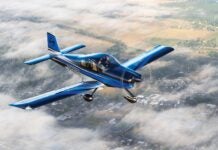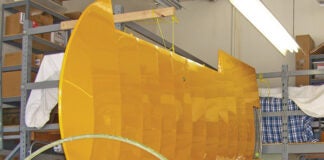
Editors note: Although we generally shy away from letting manufacturers hawk their goods on these pages-were not selling ShamWOWs here-Mike Loehle’s explanation of how his new paint system works, in itself, makes for an interesting story. When it comes time to decide on a finishing process, it helps to know as much as possible.

Mike Loehle.
I’ll start by giving a little history on our company, along with the reason I created my own painting process. I first started working with aircraft painting on fabric-covered aircraft in the late 1970s and really started experimenting with various paint processes and chemicals while working on Piper Aztecs and single-engine Cessnas. I began mixing various chemicals together in 1981 to create a shiny, chemical-resistant coating for use on my ultralights. An Oshkosh Grand Champion trophy was the result.
Over the years, I have worked with nitrates, butyrates, lacquers, vinyls, enamels, urethanes and even latex paint chemicals, and I have experience with most of the aviation paint products on the market. All work on aircraft, but some are much better and more durable. Paint has come a long way, and urethanes are the most advanced paint chemistry available today. They are really the industry standard now in auto refinishing, custom street rods and motorcycles, industrial machinery and probably even for boat refinishing. Its a shame that aviation has often been the last to adopt changes in paint technology, and the consumer really doesn’t get the latest improvements that come down the pike. My main goal working with paint for use on my own factory kit demonstrators was to create the most flexible coatings available and the easiest to apply.

Dry sanding composite parts first helps keep moisture out of the equation. Be sure to wear proper clothing and a mask.
Our process can help builders with their projects. Ill describe the basic steps I used to paint a customers Vans RV-10 and go into detail about each step. In a nutshell, heres the outline:
1. Wash and prep all parts for application of Loehle Filler/UV Blocker (primer).
2. Apply Loehle Wonder-Fil on composite parts.
3. Apply Loehle Filler/UV Blocker surface primer.
4. Apply Loehle Color Top Coating.
5. Apply Loehle Clear Top Coating.
It sounds simple enough and it really is if taken one step at a time, but there are details that make the difference between just painting something and winding up with a finely crafted paint job to match the craftsmanship you have just accomplished.
Vans Aircraft are, as most folks know, composed of primarily sheet metal with composite parts mixed throughout. The most widely asked question from Vans builders is about finishing the composite parts and especially the dreaded pinholes. Loehle Aero Coatings are purposely geared for metal, composite and fabric surfaces.
Composite Parts
The initial step for all composite parts is to trim and fit the part to the aircraft. We don’t even wash or sand the part until it is properly fitted and all holes and cutouts are finalized. Naturally, if one has to add fiberglass cloth and resin, then the applicable area should be washed and sanded per proper laminating procedures. Many builders will eat up a lot of time sanding the blemishes and actually opening up the glass surface and pinholes prior to properly fitting parts to the aircraft. This may allow dirt and grease to get into the surface of a part, only to cause paint problems later.

After the sanding, all parts should be blown off with dry, compressed air to achieve a dust-free surface.
When the part is properly fitted, wash it in hot (if possible), sudsy water to remove any mold releases, wax, oil and dirt. This should be done before sanding so as to not spread contaminants as sanding takes place. Detergents such as Simple Green and Dawn dish soap work well; just don’t use a soap that has lotion mixed into it!
The finish on composite parts varies greatly from manufacturer to manufacturer, and the amount of sanding and filling required also varies greatly. Like most in the industry, Vans parts are normally supplied unprimed, so they need to be sanded to remove the shiny finish so that filler and primer will properly adhere.
We normally prefer to dry sand our parts to keep from introducing moisture into open pinhole areas. (Be sure to wear a good, properly fitting dust mask when sanding.) We scuff sand the surface with sandpaper grit ranging from 150 to 220. The paper we use and supply is designed for dry use and is white in color. Black wet/dry paper will clog quickly when dry sanding. We learned a tremendous amount about sandpaper years ago when we produced wood Ritz propellers at our factory. Dry sanding was an obvious choice when working with wood prop blanks, so wet wood was never a factor. The paper that eliminated clogs best is what we now use for finishing glass parts.

This is what the part looks like after the initial application of Wonder-Fil, which is applied with a towel or soft cloth as though you were waxing a car.
What Are Pinholes, Anyway?
The No. 1 problem Vans builders complain about is pinholes, which are really just areas of a composite part that were starved for resin when the part was produced. The glass cloth is dry and will continue to soak up any liquid that enters the pinhole. Never fear, though. There’s a product to fill them.
Pinholes will normally repel a paint primer that is applied to an unsanded part. A pinhole is like a miniature volcano: It has a slight lip that helps repel liquid primer; actually, the thinned primer will try to flow around the lip of the pinhole instead of down into it. Surface static adds to this resistance.
Sanding will remove the volcano lip, and primer will then flow into the pinhole. The problem is that the dry fiberglass cloth keeps soaking up primer until its saturated. This may take many coats of primer, which is frustrating.

The white specks that remain show you where your pinholes are.
Years ago we wanted to hide sanding scratches in our wood propellers, and thats where Wonder-Fil started in our paint process. The chemical is a simple paint thickener and mixes with any primer, paint or even clear coatings. It mixes on the spot so that the sanding scratches disappeared on our clear-coated props. When used to fill composite pinholes, it simply plugs the hole so that primer will not continue to flow forever into the dry cloth. An old-timer explained that he used to fill sinkholes in the ground with dried beans. Then, when they soaked them with water, the expanded beans would plug the hole long enough for concrete to set. This is the basic principle in action with Wonder-Fil.
After sanding a part, it should be blown off with dry compressed air to remove the sanding dust. Surface Cleaner should be used prior to applying Wonder-Fil, and it is then simply applied with a paper towel, soft cloth or applicator sponge using a circular motion as if you were hand-waxing a car. We allow it to dry about 10 to 15 minutes until you see a whiteish haze on the parts surface and then wipe off the surface residue with a clean paper towel or soft cloth. White specks will be noticeable, and you will then realize how many pinholes your part has!

The initial spray coat of Black Filler/UV Blocker will help fill the weave of the composite fabric and block UV radiation (sunlight) that can have long-term harmful effects.

A specific design point of the Loehle Filler/UV Blocker product is that it dries to a glossy black finish as shown above.
Primer
The part is now ready for Filler/UV Blocker, which is a primer/surfacer. It comes in black or white and is designed to fill or build up mil thickness quickly. Well be using the special black on composite parts and will use the white before spraying color. The initial spray coat of blocker will help fill the weave of the composite fabric and block UV radiation (sunlight) that can destroy a parts strength over time.
Our filler/blockers are formulated to spray on in a single pass of a spray gun. Remember, high build was my goal. Fabric-covered aircraft will take four to eight coats of silver to block ultraviolet radiation (sun rays) that harm the covering fabric. A 60-watt light bulb is normally held behind the sprayed fabric to check for light penetration. Even though were not using fabric, we pass the light test with just a single slow pass of the spray gun.

After the initial sanding, any remaining shiny areas are the low spots.
The filler/blocker dries to a semi-gloss to glossy finish and has special sanding agents in it to allow the coating to be flexible, yet not clog sandpaper. When dry sanded, the shine disappears on smooth areas and blemishes show up readily as still glossy. Car painters normally spray flat gray primer and then apply a coat of flat black spraycan primer on top of the gray. When they sand the surface, low spots show up as flat black. This cheater method is called a guide coat. Our filler/blockers have this designed into them. The remaining shiny areas show the low spots just like the rattle can flat black does for car painters. Loehle products, however, do not introduce cheap lacquer-based paints into proper urethane primers.
A word about thinner (or reducer) formulas. All Loehle chemicals use the same thinners. This is unique to painting products, especially aviation products. This means there is little chance that the chemicals will react to each other, as happens with some coating products. It has always been obvious to me that part of the popping of paint that folks complain about is a result of different chemicals reacting to each other. You don’t have that problem when the same chemicals are used across a range of products.
Loehle thinners come in seven temperature ranges from 50 to 115 to allow the chemicals to flow properly and achieve the desired result. Typical aviation coatings will usually offer two temperature range thinners and then have blush retarders to slow the drying process further. Body shops normally have their own heat booths to help with this. All our chemicals are designed to be applied in homebuilders workshops and be air dried. A heated booth can be used, but it is not required.

Allow the part to dry well before you start to sand it. This time can vary from 5 minutes to an hour or so depending on the temperature of your shop and which thinner you chose. Setting the part into direct sunlight will speed up the drying process.
The first coat of the black filler/blocker can be sanded in 5 to 10 minutes if the fast drying Accelerated Thinner is used. Normally one does not need to sand that fast, but you have the option.
Note: Spray guns must be cleaned immediately after using all of our products, as the chemicals are designed to set up quickly to reduce dust and dirt from contaminating the paint. Most builders don’t have perfect dust-free paint booths, and our shop doesn’t either. Until recently, our paint shop was a dusty wood propeller shop or the great outdoors! This is why I created this painting process. Who would think you could paint a $750,000 Lancair PropJet without a perfect dust-free paint booth and achieve a mirror finish?
Thats enough of the chemical details for now. Next time, we’ll start the painting portion of the project.
For more information, starter kits or quotes for materials, call Sandy Loehle at 931-857-3419 or visit www.loehle.com.













